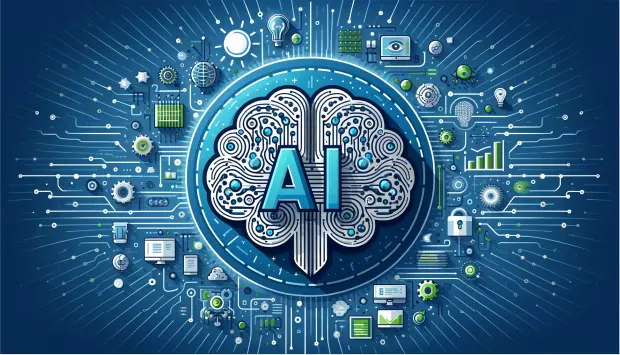Artificial Intelligence (AI): Definition & How it Works
Artificial Intelligence (AI) is a fascinating and rapidly evolving field. It has captured the imagination of researchers, businesses, and the general public alike. In this comprehensive guide, we will explore the definition of AI, its history and its various subfields. You’ll have a better understanding of the fascinating world of AI by the end of this article.
What is Artificial Intelligence (AI)?
Artificial Intelligence is often abbreviated as AI. It is the simulation of human intelligence in machines. AI refers to the development of computer systems that can perform tasks that typically require human intelligence. For example such as visual perception, speech recognition, decision-making, and problem-solving.
AI systems aim to replicate human cognitive abilities. It makes them capable of learning from experience, adapting to new information, and improving their performance over time. This capacity for self-improvement and continuous learning is what sets AI apart and drives its potential for innovation across diverse fields.
The History of Artificial Intelligence (AI)
The concept of AI dates back to ancient myths and stories of machines with human-like qualities. However, the formalization of AI as a field of study began in the mid-20th century. In addition, a group of researchers organized the Dartmouth Conference 1956. There they coined the term “artificial intelligence” and outlined the goals of creating machines that could simulate human intelligence.
The early years of AI research were marked by high expectations and significant funding, but progress was slower than anticipated. Researchers faced numerous challenges in building intelligent machines, and AI experienced periods of stagnation known as “AI winters“. However, these setbacks did not deter scientists, and AI continued to evolve.
Artificial Intelligence (AI) Subfields
Artificial Intelligence (AI) is a broad field with several subfields. Each field focuses on different aspects of replicating human intelligence. Here are some key subfields of AI:
- Machine Learning (ML): Machine learning is a subset of AI that focuses on developing algorithms. It allow computers to learn from and make predictions or decisions based on data. It has found applications in various domains, from recommendation systems to image recognition.
- Natural Language Processing (NLP): NLP focuses on enabling computers to understand, interpret, and generate human language. Applications include chatbots like AI WhatsApp Chatbot, language translation, and sentiment analysis.
- Computer Vision: This subfield is concerned with teaching computers to interpret and understand visual information from the world, such as images and videos. Computer vision has enabled advances in facial recognition, autonomous vehicles, and medical image analysis.
- Robotics: Robotics combines AI with mechanical engineering to create intelligent machines capable of performing physical tasks. To illustrate: industrial robots, drones, and even humanoid robots.
- Expert Systems: Expert systems are AI programs designed to mimic the decision-making abilities of human experts in specific domains. They are used in fields like medicine, finance, and engineering for diagnostic and problem-solving purposes.
How AI Works
Artificial intelligence (AI) systems rely on a combination of data, algorithms, and computing power to simulate human intelligence. Data serves as the fuel that AI systems need to learn and make informed decisions. In contrast, algorithms provide the rules and processes for interpreting and processing this data. In a nutshell here’s how it works:
- Data Collection: AI systems require a vast amount of data to learn and make decisions. This data can be structured (e.g., databases) or unstructured (e.g., text or images). In fact he more data available, the better the AI can learn and adapt.
- Data Preprocessing: Raw data often needs to be cleaned, organized, and prepared for analysis. This step involves data cleaning, feature extraction, and transformation to make the data suitable for AI algorithms.
- Training: Machine learning models are trained on the prepared data. The AI system uses algorithms to identify patterns, correlations, and relationships within the data during training. As a result. it helps the AI system learn from past experiences.
- Inference: After training, the AI model can make predictions or decisions based on new, unseen data. This is known as inference. The model applies what it has learned to solve real-world problems, such as classifying objects in images, generating text, or making recommendations.
- Feedback Loop: AI systems can continuously improve through a feedback loop. As they encounter new data and make predictions, feedback is used to update and refine the model, enhancing its accuracy and performance over time.
Challenges and Ethical Considerations
While AI has made remarkable advancements. But it also faces various challenges and ethical considerations:
- Bias and Fairness: AI systems can inherit biases present in the data they are trained on. The biasness leads to unfair or discriminatory outcomes. It ensures fairness in AI is an ongoing challenge.
- Transparency: Many AI models are complex “black boxes” that make it challenging to understand how they reach specific decisions. Also the efforts are underway to improve model interpretability.
- Privacy: The vast amount of data required for AI raises concerns about privacy and data security. Striking a balance between AI advancements and individual privacy is crucial.
- Job Displacement: The automation potential of AI raises concerns about job displacement in certain industries. Preparing the workforce for these changes is a pressing issue.
Artificial Intelligence is a transformative technology with the potential to revolutionize industries. Certainly improving various aspects of our lives. Actually understanding the definition and workings of AI is essential for anyone interested in this exciting field.
As AI continues to evolve, it will be crucial to address ethical considerations and challenges to ensure its responsible and beneficial use in society. So, the future of AI holds tremendous promise, and it is up to us to shape it in a way that benefits humanity as a whole.



